
Organic reaction mechanisms. 1998 / 15
.pdf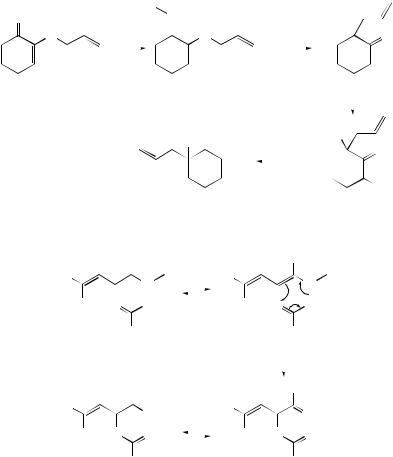
15 Molecular Rearrangements |
517 |
O
O
(80)
Ph
R′
Ph
R′
|
|
|
δ+ |
|
|
|
|
|
|
|
|
|
|
|
|
|
|
|
|
|
|||
|
Bu3Sn δ− |
|
|
|
|
|
|
|
|
|
δ+ |
|
|
|
δ− |
||||||||
|
|
|
|
O |
|
|
|
|
|
|
|
Bu3Sn |
|
|
|
O |
|||||||
|
|
|
|
|
|
|
|
|
|
|
|
||||||||||||
|
|
|
|
|
|
|
O |
|
|
|
|
|
|
|
|
|
|
|
|
|
O |
||
|
|
|
|
|
• |
|
|
|
|
|
|
|
|
|
|
|
|
|
|
|
|
• |
|
|
|
|
|
|
|
|
|
|
|
|
|
|
|
|
|
|
|
|
|
|
|||
|
|
|
|
|
|
|
|
|
|
|
|
|
|
|
|
|
|
|
|
|
|||
|
|
|
|
|
|
|
|
|
|
|
|
|
|
|
|
|
|
HSnBu3 |
|
||||
|
|
|
|
|
|
|
|
|
|
|
|
|
|
|
|
|
|
|
|
|
|
|
|
|
|
|
|
|
|
|
O |
|
|
|
|
|
δ+ |
|
|
δ− |
|||||||
|
|
|
|
HO |
|
|
|
Bu3Sn |
|
|
|
O |
|||||||||||
|
|
|
|
|
|
|
|
|
|
||||||||||||||
|
|
|
|
|
|
|
|
|
|
|
|
|
|||||||||||
|
|
|
|
|
|
|
|
|
|
|
|
|
|
|
|
|
|
|
|
O |
|||
|
|
|
|
|
|
|
|
|
|
|
|
|
|
|
|
|
|
|
|
|
|
|
|
|
(81) |
|
|
|
|
|
|
|
|
|
|
|
|
|
|
|
|
H |
|||||
|
|
|
|
|
|
|
|
|
|
|
|
|
|
|
|
|
|||||||
|
|
|
|
|
|
|
|
|
|
|
|
|
|
|
|
|
|
||||||
|
|
|
|
SCHEME 34 |
|
|
|
|
|
|
|
|
|
|
|
|
|
|
|||||
|
O |
|
|
|
|
|
|
OH |
|
|
|
|
|
||||||||||
|
|
|
|
R |
|
|
Ph |
|
|
|
|
|
|
|
|
|
|
R |
|||||
|
|
|
N |
|
|
|
|
|
|
|
N |
|
|
|
|
|
|||||||
|
|
|
|
|
|
|
|
|
|
|
|
|
|
|
|||||||||
|
|
|
|
|
|
|
|
R′ |
|
|
|
|
|
|
|
|
|
|
|
||||
|
|
|
|
|
|
|
|
|
|
|
|
|
|
|
|
|
|
|
|
|
|
|
|
O |
|
|
O |
|
|
|
O |
|
|
O |
|
|
|
|
|
||||||||
|
Ph |
|
|
|
|
|
|
Ph |
|
|
|
|
|
||||||||||
|
(82) |
|
|
|
|
|
|
|
|
|
|
|
|
|
|
|
|
|
|
|
|
||
|
|
|
|
|
|
|
|
|
|
|
|
|
|
|
|
|
|
|
|
|
|||
|
O |
|
|
|
|
|
|
OH |
|
|
|
|
|
||||||||||
|
|
|
|
|
|
|
|
|
|
|
|
||||||||||||
O |
|
|
NHR |
|
|
Ph |
R′ |
O |
|
N |
|
|
|
R |
|||||||||
|
|
|
|
|
|
|
|||||||||||||||||
|
|
|
|
|
|
|
|
||||||||||||||||
|
|
|
|
|
|
|
|
||||||||||||||||
|
|
O |
|
|
|
|
|
|
|
O |
|
|
|
|
|
||||||||
|
|
|
|
|
|
|
|
|
|
|
|
|
|
||||||||||
|
|
|
|
|
|
|
|
|
|
|
|
|
|||||||||||
|
Ph |
|
|
|
|
|
|
Ph |
|
|
|
|
|
||||||||||
|
(83) |
|
|
|
|
|
|
|
|
|
|
|
|
|
|
|
|
|
|
|
|
||
SCHEME 35
4-(2-Aminoethyl)indoles have been prepared137 from 3-hydroxy-2-methoxyindolines by way of a Claisen o-amide rearrangement. O-Acylhydroxamic acid derivatives (82) have been found to undergo a base-catalysed rearrangement to give secondary 2-acyloxyamides (83). The authors138 have suggested that the mechanism proceeds via an anionic hetero[3,3]-sigmatropic rearrangement of the corresponding enol or enolate (see Scheme 35). In the presence of various acylating agents, camphor-derived oxazoline N -oxides (84) have been found to afford α-acyloxyoxazolines (85) resulting from a diastereoselective [3,3]-rearrangement.139
The asymmetric aza-Claisen rearrangement of allyl imidates, (86) → (87), has been shown to be catalysed by homochiral cationic palladium(II) complexes,140 and a series of enantiopure cyclopalladated ferrocenyl amines and imines have been

518 |
|
|
|
|
|
|
Organic Reaction Mechanisms 1998 |
||
Me |
Me |
|
|
|
Me |
Me |
|
||
|
N |
|
H |
|
|
N |
H |
||
|
|
|
Me |
O |
|||||
|
|
|
|
|
|
||||
Me |
O |
|
|
|
R1 |
|
R1 |
||
|
|
|
|
||||||
|
|
|
|
||||||
|
O |
O |
|
|
O |
O |
|||
|
|
|
|
|
|
|
|
|
|
R2
(84)
Ph
Ar |
Ar |
NO
|
R |
|
|
|
R |
|
|
|
|
(86) |
|
|
|
|
|
|
|
|
|
+ |
R1 |
|
|
|
|
R1 |
Br |
R2 |
|
|
|
R2 |
||
|
|
|
|
|||
O |
NH |
|
|
O |
NH |
|
|
|
|||||
|
CCl3 |
|
|
|
CCl3 |
|
R1 R2
O NH
CCl3
R2
(85)
O
N Ph
(87)
Br
R1  R2
R2
+
O  NH
NH
CCl3
Br+ |
R2 |
R1 |
|
O |
NH |
|
CCl3 |
SCHEME 36
established141 as efficient catalysts for the [3,3]-sigmatropic rearrangement of allylic imidates to allylic amides. Improved conditions have been developed142 for the [3,3]- sigmatropic rearrangement of trichloroacetamides, and a novel, efficient and stereospecific method for the [3,3]-sigmatropic rearrangement of (E)-allylic trichloroacetimidates bearing electron-withdrawing groups has been reported143 (see Scheme 36). A sequence of [3,3]-sigmatropic isomerizations of the type (88) → (89) → (90) has been utilized to provide a convenient approach to 1,2-difunctionalized buta-1,3- dienes.144
A theoretical study of substituent effects in the thio-Claisen rearrangement (91) → (92) has been carried out. The study145 has shown that 2,5-disubstitution leads to tighter transition states and to a substantial lowering of the enthalpy of

15 Molecular Rearrangements |
|
|
|
|
|
|
|
|
|
|
|
|
|
|
519 |
||||||
Y Z |
|
|
|
|
|
|
|
|
Y |
Z |
|
|
|
|
X |
Y |
|||||
X |
[3,3] |
|
|
X |
|
|
|
[3,3] |
|
Z |
|||||||||||
|
|
• |
|
|
|
||||||||||||||||
Z |
|
|
|
|
|
|
|
|
|
|
|
|
|
|
|
X |
|
||||
Y |
|
|
|
|
|
|
|
|
|
X |
|
Z |
|
|
|
|
Z |
||||
X |
|
|
|
|
|
|
|
|
|
|
|
|
|
|
Y |
|
|||||
|
|
|
|
|
|
|
|
|
|
|
|
|
Y |
|
|
|
|
|
|
||
(88) |
|
|
|
|
|
|
|
(89) |
|
(90) |
|||||||||||
e.g. XYZ = C |
|
|
CO2R, C |
|
C |
|
C |
|
|
|
|
R1 |
|
||||||||
|
|
|
|
|
|
|
|
||||||||||||||
|
|
|
|
R1 |
|
|
|
|
|
|
|
|
|
|
|
||||||
R2 |
|
|
|
|
|
|
|
|
|
|
|
R2 |
|
|
|
|
|
|
|||
|
|
|
X |
S |
|
|
|
|
|
|
|
|
X S |
|
|||||||
|
|
|
|
|
|
|
|
|
|
|
|
||||||||||
|
|
|
|
|
|
|
R |
|
|
|
|
|
|
|
|
|
|
|
|
R |
|
|
|
|
|
|
|
|
|
|
|
|
|
|
|
|
|
|
|
|
|
||
|
|
|
|
|
|
|
|
|
|
|
|
|
|
|
|
|
|
|
|
||
|
|
(91) |
|
|
|
|
|
|
|
|
|
(92) |
|
|
|||||||
X = CH, N |
|
|
|
|
|
|
|
|
|
|
|
|
|
|
|||||||
activation. Quantum-chemical calculations of the [3,3]-sigmatropic rearrangement of S-allyl O-methyl N -(2- and 4-substituted acridin-9-yl)thiocarbonimidates have pointed to a chair configuration in the transition state of the reaction,146 and a new synthetic route to N -allyl-N -(9-acridinyl)thiocarbamic acid O-methyl and S-methyl esters via the [3,3]-sigmatropic rearrangement of O(S)-methyl-S(O)-allyl-N -(9- acridinyl)iminothiocarbonates has been elaborated.147 The thio-Claisen rearrangement has proved to be a powerful synthetic tool in the preparation of a (−)-trichodiene intermediate bearing vicinal stereogenic quaternary centres.148 A recent analysis has shown that the concerted [3,3]-sigmatropic rearrangement of allylic xanthates in protic solvents, and the ionic rearrangement in hydroxylic solvents, are extremes in a continuous spectrum of mechanism for the thione-to-thiol rearrangement. The solvation mode for the rearrangement via an ionic intermediate was found to be different from that of the concerted mechanism.149
Cope and related rearrangements
Characteristics and energetics of the photo-induced electron-transfer degenerate Cope rearrangement of 2,5-diarylhexa-1,5-dienes have been reported in detail.150 Oxygentrapping experiments have established151 the two-step nature of the rearrangement of (93) to (94) (see Scheme 37), while it has been shown that both [2.2.2]propellane and the Cope rearrangement of hexa-1,5-diene follow reaction paths that pass through singlet diradicaloid portions of the potential-energy surface.152 A theoretical analysis of the Cope rearrangements of hexa-1,5-diyne, hexa-1,2-dien-5-yne, hexa-1,2,5-triene,
•
•
(93)
(94)
SCHEME 37

520 Organic Reaction Mechanisms 1998
hexa-1,2,4,5-tetraene, and hexa-1-en-5-yne, has been undertaken.153 In each case the mechanism was predicted to be concerted through an aromatic transition state. The effect of deuterium substitution on the positional equilibrium and rate of the Cope rearrangement of barbaralone-d(1) has been investigated154 by 1H and 13C dynamic NMR spectroscopy. It has been proposed that every transition state should be accompanied by a bond-excited state with a similar structure, the properties of which should in principle be measurable by spectroscopic methods and can thus constitute a source of information about the transition state. This idea has been demonstrated computationally through the example of the degenerate Cope rearrangement of semibullvalene.155 The effects of substituents on the degenerate Cope rearrangement of semibullvalenes and barbaralones have been reviewed,156 and the mechanism of the Cope rearrangement in halobullvalenes in solution and in the solid state has been investigated by
NMR techniques.157 |
|
|
|
It has been established158 |
that the course of the |
sequential |
pericyclic |
reaction of cyclopentadienones |
with acyclic conjugated |
alkadienes |
depends |
on the reaction temperature, thermal treatment at low temperatures affording 3a,4,7,7a-tetrahydroinden-1-one derivatives by way of a Cope rearrangement (see Scheme 38). Roman et al.159 have developed an efficient stereoselective synthesis of enantiomerically pure 1-nitrotricyclo[5.2.2.02,6]undeca-3,8-dienes via a tandem consecutive asymmetric Diels–Alder–Cope rearrangement (see Scheme 39). Adducts
|
|
|
|
O |
|
|
|
|
|
|
|
|
|
|
|
O |
|
|
|
|
||||
|
|
|
R |
|
|
|
R |
R1 |
|
|
|
R2 |
|
Ar |
|
R |
|
R |
1 |
|
||||
|
|
|
|
|
|
|
|
|
|
|
|
|
||||||||||||
|
|
|
|
|
|
|
|
|
|
|
|
|
|
|
|
|
|
|
|
|
|
|
||
|
|
|
Ar |
Ar |
|
|
|
|
|
|
|
Ar |
R |
R2 |
|
|
||||||||
|
|
|
|
|
|
|
|
|
|
|
|
|
|
|||||||||||
|
|
|
|
|
|
|
|
|
|
|
|
|
|
|
|
|
|
|
or |
|
|
|
|
|
|
|
|
R2 |
|
|
|
|
|
|
|
|
|
|
|
O |
|
|
|
|
|||||
|
|
|
Ar |
|
|
|
|
|
|
|
|
|
|
|
|
|
|
|
|
|||||
|
|
|
|
Ar |
|
|
|
|
|
|
|
|
Ar |
|
R |
R1 |
|
|
||||||
|
|
|
|
|
|
|
|
|
|
|
|
|
|
|
|
|
||||||||
|
|
|
|
|
|
|
|
|
|
|
|
|
|
|
|
|
|
|
|
|||||
|
|
|
R1 R |
|
R |
|
|
|
|
|
|
|
Ar |
R |
|
|
|
|
||||||
|
|
|
|
|
|
|
|
|
|
|
|
|
|
|
||||||||||
|
|
|
|
|
|
|
|
|
|
|
|
|
|
|||||||||||
|
|
|
|
|
|
|
|
|
|
|
|
|
|
|
|
|||||||||
|
|
|
O |
|
|
|
|
|
|
|
|
|
|
|
|
R2 |
|
|
||||||
|
|
|
|
|
|
|
|
|
|
|
|
|
|
|
|
|
|
|
|
|
|
|
||
|
|
|
|
|
|
|
|
|
|
|
SCHEME 38 |
|
|
|
|
|
|
|
|
|
||||
O |
|
|
|
|
|
|
|
|
|
O |
|
|
|
|
OH |
|||||||||
|
|
|
|
|
|
|
|
|
|
|
|
|
||||||||||||
|
|
OMe |
|
|
|
|
|
|
|
|
|
|
|
|
|
|
|
|
|
|
||||
|
|
O |
|
|
|
O |
|
|
|
O |
|
|
|
O |
||||||||||
|
|
|
|
|
|
|
|
|
|
|
||||||||||||||
|
|
|
|
|
|
|
|
|
|
|
|
|
|
|
|
|||||||||
|
|
|
|
|
|
|
|
|
O |
OMe |
|
|
|
|
|
|
|
|
|
|
||||
|
|
|
|
|
|
|
|
|
|
|
|
|
|
|
|
|
|
|
|
|||||
|
|
|
|
|
|
|
|
|
|
|
|
|
|
|
|
|
|
|
||||||
|
|
|
|
|
|
|
|
|
|
|
|
|
|
|
|
|
|
|
|
|
|
|||
|
|
|
|
|
|
|
|
|
|
|
|
|
|
|
|
|
|
|
|
|
|
|
|
|
(95) |
(96) |
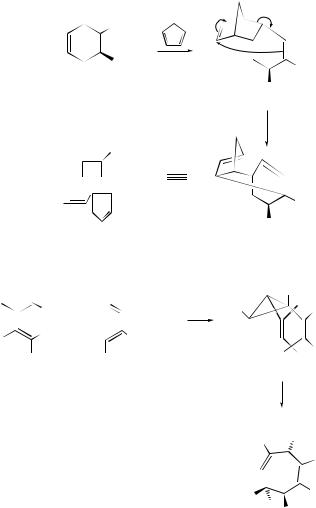
15 Molecular Rearrangements |
521 |
of the intramolecular Diels–Alder reaction of o-benzoquinone monoketals, viz. (95), have been rapidly converted via Cope rearrangements to naphthofurans (96) and phenanthrofurans related to (−)-morphine.160 Catalytic amounts of bis(benzonitrile)palladium(II) chloride have been found161 to enhance the Cope rearrangement of germacranolides to elemanolides.
Rhodium(II) (N -dodecylbenzenesulfonyl)prolinate has been found to act as an effective catalyst for the enantioselective decomposition of vinyldiazoacetates to cis-divinylcyclopropanes. Combination of this process with a subsequent Cope rearrangement has resulted162 in a highly enantioselective synthesis of a variety of cycloheptadienes containing multiple stereogenic centres (see Scheme 40). The tandem
NO2
S
S = D-galacto-(CHOAc)4CH2OAc
S

 NO2
NO2
SCHEME 39
R6 |
R7 |
N2 |
CO2Me |
|
+ |
|
|
|
R3 |
|
|
R5 |
|
R1 |
|
|
|
||
R4 |
|
R2 |
|
SCHEME 40
NO2
S
NO2
S
CO2Me |
|
|
|
|
|
R6 |
R1 |
|
|
H |
|
R5 |
||
R7 |
|
|
|
|
R |
3 |
R |
2 |
R4 |
|
|
|
||
R6 R7
CO2Me
R5
R4 |
R′ |
R3 |
R2 |
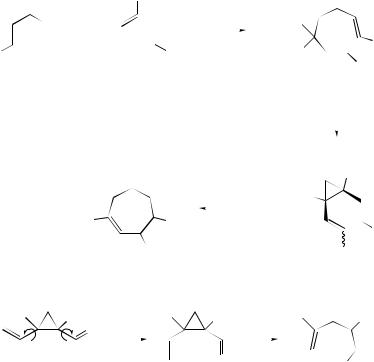
522 Organic Reaction Mechanisms 1998
cyclopropanation–Cope rearrangement sequence has been used to synthesise members of the tremulane sesquiterpenes.163 A useful and mechanistically interesting 3 + 4- annulation methodology has been reported for the stereo-controlled construction of highly functionalized cycloheptenone derivatives. The reaction has been presented164 as an anionic oxy-Cope reaction of a 1,2-divinylcyclopropanediol intermediate generated via a Brook rearrangement of the 1,2-adduct of a lithium enolate (see Scheme 41). The prototypical 1,2-cis-vinylcyclopropanecarbaldehyde to 2,5- dihydrooxepin hetero-Cope type rearrangement (see Scheme 42) has been studied165 by density functional theory. Divinylcarbinols of the type (97) have been found to undergo oxy-Cope rearrangement very rapidly at low temperatures although the rearrangement was found to proceed in a reversible manner. It appears166 that the return to alkoxide can materialize only as long as the enolate anion has its oxygen atom oriented up towards the methano bridge as in (98). However, such a structure is thermodynamically unstable relative to its oxygen-down form (99).
NMR and kinetic studies have been carried out167 on the antibody-catalysed oxyCope rearrangement of hexadiene (100) to aldehyde (101). An aromatic oxy-Cope rearrangement involving a benzene ring [see (102) → (103)] has been observed to
|
|
O |
|
|
OLi |
|
|
|
|
|
O |
||||||||
|
|
|
|
SiR′3 + |
|
|
|
|
|
|
|
|
|
|
O− |
|
|
|
R |
|
|
|
|
|
|
|
|
|
|
|
|
|
|
|
|
|
|||
|
|
|
|
|
|
|
|
|
|
|
|
|
|
|
|
||||
|
|
|
|
|
|
|
|
|
|
|
|
|
|
||||||
|
|
|
|
|
|
R |
|
|
|
|
R′3Si |
|
|
|
|||||
|
|
|
|
|
|
|
|
|
|
|
|
|
|
|
|
||||
X |
|
|
|
|
|
|
|
|
|
|
|
|
|
|
|||||
|
|
|
|
|
|
|
|
|
|
|
|
|
X |
||||||
|
|
|
|
|
|
|
|
|
|
|
|
|
|
|
|
|
|
||
|
|
|
|
|
|
|
|
|
|
|
|
|
|
|
|
|
Brook |
||
|
|
|
|
|
|
|
|
|
|
|
|
|
|
|
|
|
|||
|
|
|
|
|
O |
|
|
|
|
|
|
O− |
|||||||
|
|
|
|
|
|
|
|
|
|
|
|||||||||
|
|
|
|
R′3SiO |
|
|
|
|
|
|
oxy-Cope |
|
R′3SiO |
|
|||||
|
|
|
|
|
|
|
|
|
|
|
|
|
|
|
|||||
|
|
|
|
|
|
|
|
R |
|
|
|
|
|
|
|
|
R |
||
|
|
|
|
|
|
|
|
|
|
||||||||||
|
|
|
|
|
|
|
|
|
|
|
|
|
|
|
|
|
|
|
|
|
|
|
|
|
|
|
|
X |
|
|
|
|
|
|
X |
||||
|
|
|
|
|
|
|
|
|
SCHEME 41 |
|
|
|
|
|
|
||||
R1 |
|
|
R2 |
|
|
|
|
R1 |
R2 |
|
R1 |
|
|
|
R2 |
||||
|
|
|
|
O |
|
|
|
|
|
|
|
|
|
|
|
|
|
|
|
|
|
|
|
|
|
|
|
|
|
|
|
|
|
|
|
|
|
|
|
O  O
O
SCHEME 42

15 Molecular Rearrangements |
523 |
Me Me |
|
|
|
|
|
|
|
|
|
Me Me |
OMOM |
||||||||||||
|
|
|
|
|
|
|
|
|
|
|
|
|
|
|
|
|
|
|
|
|
|||
|
|
OMOM |
|
|
|
|
|
|
|
|
|
|
|
|
|
H |
|
|
O−K+ |
||||
|
|
OH |
|
|
|
|
|
|
|
|
|
|
|
|
|
|
|
|
|||||
|
|
|
|
|
|
|
|
|
|
|
|
|
|
|
|
|
|
|
|
||||
|
|
|
|
|
|
|
|
|
|
|
|
|
|
|
|
|
H |
|
|
Me |
|||
|
|
|
|
|
|
|
|
|
|
|
|
|
|
|
|
|
|
|
|||||
|
|
|
|
|
|
|
|
|
|
|
|
|
|
|
|
|
|
|
|
||||
BnO |
|
Me |
|
|
|
|
|
|
|
|
|
BnO |
|
|
OTBS |
||||||||
|
|
|
|
|
|
|
|
|
|
|
|
|
|
|
|
|
|
||||||
|
|
|
|
|
|
|
|
|
|
|
|
|
|
|
|
|
|
|
|
||||
|
|
OTBS |
|
|
|
|
|
|
|
|
|
|
|
|
|
O |
|
|
|
||||
|
O |
|
|
|
|
|
|
|
|
|
|
|
|
|
|
|
|
||||||
|
|
|
|
|
|
|
|
|
|
|
|
|
|
|
|
|
|
|
|||||
|
(97) |
|
|
|
|
|
(98) |
|
|||||||||||||||
|
|
|
Me |
|
|
Me |
|
|
|
||||||||||||||
|
|
|
|
|
|
|
|
|
|
|
OMOM |
|
|
|
|||||||||
|
|
|
|
|
|
|
|
|
H |
|
|
|
|||||||||||
|
|
|
|
|
|
|
|
|
|
|
|
|
|
|
|
|
|
|
|
|
|
||
|
|
|
|
|
|
H |
|
|
OK |
|
|
|
|||||||||||
|
|
|
BnO |
|
|
|
|
|
|
|
Me |
|
|
|
|||||||||
|
|
|
|
|
|
|
|
|
|
|
|
|
|
|
|||||||||
|
|
|
|
|
|
|
|
|
|
|
|
|
|
OTBS |
|
|
|
||||||
|
|
|
|
|
|
|
|
|
|
|
|
|
|
|
|
|
|
|
|
||||
|
|
|
|
|
|
|
|
|
O |
|
|
|
|||||||||||
|
|
|
|
|
|
|
|
(99) |
|
|
|
|
|
|
|
|
|
||||||
|
|
|
|
|
|
|
|
|
|
|
|
|
|
|
|
|
|
|
|
|
|
|
O |
|
|
|
|
|
|
|
|
|
|
|
|
|
|
|
|
|
|
|
|
|
|
|
|
|
|
|
|
|
|
|
|
|
|
|
|
|
|
|
|
|
|
|
|
|
|
|
|
|
|
|
|
|
|
|
|
|
|
|
|
|
|
|
|
|
|
|
|
|
|
|
H |
|
|
OH |
|
|
|
|
|
|
|
|
|
|
|
|
|
|
|
|
|
||||
|
|
|
|
|
|
|
|
|
|
|
|
|
|
|
|
|
|
|
|
||||
|
|
|
|
|
|
|
|
|
|
|
|
|
|
|
|
|
|
|
|||||
|
|
|
|
|
|
|
|
|
|
|
|
|
|
|
|
|
|
|
|
||||
|
(100) |
|
|
|
|
|
(101) |
|
|
|
|||||||||||||
|
|
|
|
|
|
|
|
|
|
|
|
|
|
|
|
|
O |
|
|
|
|||
|
|
|
|
|
|
|
|
|
|
|
|
|
|
|
|
|
|
|
|
|
|
|
|
|
HO |
|
|
|
|
|
|
|
|
|
|
|
|
H |
|
|
|
|
|||||
|
|
|
|
|
|
|
|
|
|
|
|
|
|
|
|
|
|||||||
|
|
|
|
|
|
|
|
|
|
|
|
|
|
|
|
|
|
|
|
|
|
|
|
|
|
|
|
|
|
|
|
|
|
|
|
|
|
|
|
|
|
|
|
|
|
|
|
H
MeO
OMe
(102) |
(103) |
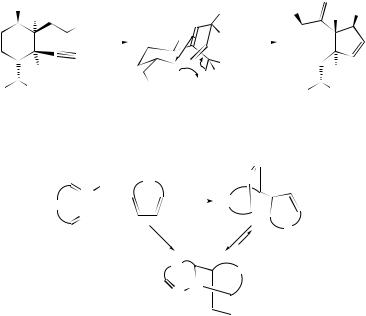
524 |
|
|
|
|
|
|
|
|
|
Organic Reaction Mechanisms 1998 |
||||
|
Me |
|
|
|
|
|
E |
|
Me |
H |
E |
|||
|
Me |
|
|
|
|
|
|
|||||||
|
|
|
|
|
|
|
|
|
|
|||||
|
|
E |
|
|
|
Me |
|
|
|
|
|
|||
|
|
|
|
|
|
|
|
H |
|
|
|
|
||
|
|
|
|
|
|
|
|
|
|
|
|
|
|
|
|
OH |
|
|
|
|
|
H |
|
|
OH |
|
|||
|
|
|
|
|
|
|
|
|
||||||
|
Me |
|
|
H H |
|
|
|
|||||||
Me |
Me |
Me O |
|
Me |
Me |
|
||||||||
|
|
|
|
|
|
|||||||||
|
(104) |
|
|
|
|
|
|
|
|
|
|
|
(105) |
|
E = CO2Et |
|
|
|
|
|
|
|
|
|
|
||||
|
R |
|
|
|
|
|
|
N |
|
|
||||
|
|
|
|
|
|
|
N |
|
|
|||||
|
|
+ |
|
H |
Y |
4+ + 2 |
|
|
|
|||||
|
|
|
|
|
|
|
|
|||||||
|
|
N |
+ |
|
|
X |
|
|
|
|
||||
|
X |
|
|
|
|
−H+ |
|
|
|
|
||||
|
|
|
|
|
|
|
|
|
|
|
||||
|
|
N |
|
|
|
|
|
|
|
Y |
|
|
||
|
|
|
|
|
|
|
4 + 2+ |
[3,3] |
|
|
|
|||
|
|
|
|
|
|
|
−H+ |
|
|
|
|
|
|
|
X
Y
N
N
SCHEME 43
take place168 when 1-methoxy-2-arylbicyclo[2.2.2]oct-5-en-2-exo-ols are treated with potassium hydride in THF. The thermally allowed oxy-Cope rearrangement of the optically active ethynyl alcohol (104) has been used169 to construct the functionalized hydrazulenoid skeleton (105). A short, stereoselective synthesis of the C(1)−C(10) polyol fragment of nystatin A has been achieved170 using a highly selective and efficient oxy-Cope rearrangement of a chiral unprotected aldol product as the key step, and a stereoselective synthesis of the natural product (+)-lasiol has been carried out in a similar manner using a silyloxy-Cope rearrangement of a chiral aldol product.171 It has been demonstrated for the first time172 that an anion-accelerated oxy-Cope rearrangement can produce strained medium-ring compounds from larger, less strained carbocycles.
The first unambiguous glimpse of the heteroatomic modulation of oxyanionic Cope rearrangement rates has been described173 in the context of paclitaxel synthesis. Recent calculations have indicated174 that anionic oxy-Cope substrates
react |
via a concerted pathway, whereas |
anionic amino-Cope substrates react |
|||||
via |
a |
stepwise, heterolytic |
cleavage |
pathway. It has been demonstrated175 that, |
|||
in |
the acid-catalysed 4 + 2-cycloaddition |
between cyclic azines and 1,3-dienes, |
|||||
both |
partners may play the role |
of the diene or the dienophile, depending |
|||||
on |
particular structural features. Moreover, it has been shown that the thermal |
||||||
or |
acid-catalysed interconversion of |
isomeric 4 + 2-cycloadducts |
definitely occurs |
||||
by |
a |
Cope rearrangement |
and |
not |
by a |
4 + 2-cycloreversion |
(see Scheme 43). |
3-Alkylideneindolin-2-ones |
have |
been prepared from propargylbenzotriazoles via |
|||||
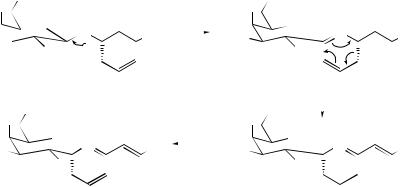
15 Molecular Rearrangements |
525 |
a selective nucleophilic reaction of an allene dianion followed by a 3-aza-Cope rearrangement,176 and the reaction of 1-methyl-1-cyanohydrazones with methyl trifluoromethanesulfonate was found to afford 2-(methylamino)-1-methylimidazoles as their triflic acid salts. The authors177 have proposed that this transformation involves the formation of the 1-cyano-1,2-dimethyl ene-hydrazine derivative which undergoes a 1,3,4-triaza-Cope rearrangement in situ. Chain-extended amino sugar derivatives have been synthesized178 via the stereo-controlled Lewis acid-catalysed aza-Cope rearrangement of N -glycosylhomoallylamines (see Scheme 44). The anionic aminoCope rearrangement of a series of 3-amino-1,5-diene substrates has been achieved179 at low temperatures by using butyllithium to generate the lithium anion. The absolute stereochemistry of the major product has been predicted from simple transition-state models, the major enantiomer being produced from a chair-like conformation of the substrate with the amine component occupying a pseudo-equatorial orientation. High asymmetric induction has also been achieved in the anionic amino-Cope rearrangement of 3-amino-1,5-dienes by using β-amino alcohol auxiliaries.180
PivO
PivO
OPiv
LA ••••
 O
O 
OPiv
H
N
• •
OPiv
|
|
PivO |
|
|
|
|
Ph |
|
−OLA |
H |
+ |
|
Ph |
|
PivO |
N |
|
|
||
|
|
|
||||
|
|
|
|
|
|
|
|
|
OPiv |
|
|
|
|
PivO |
OPiv |
|
|
|
OPiv |
|
|
|
|
|
|
|
|
|
|
PivO |
|
|
|
|
|
|
OH |
|
|
|
− |
|
H |
+ |
|
|
|
N |
Ph |
|
OLA |
|
Ph |
||||
PivO |
|
|
|
PivO |
|
N |
|
|||
|
|
|
|
|||||||
|
|
|
|
|
|
|
|
|
||
|
PivO |
|
|
|
|
OPiv |
|
|
|
|
SCHEME 44
[2,3]-Migrations
The tactical combination of Diels–Alder reactions with [2,3]-sigmatropic rearrangements, as well as the one-pot version of these tandem processes, have been used to create unusual structures with high efficiency.181 The influence of the relative stereochemistry of the epoxide and benzyloxy functionalities present in cis- and trans-1-benzyloxy-3,4-epoxycyclopentanes on the tandem epoxide–allylic alcohol [1,2]/[2,3]-Wittig rearrangement has been studied,182 together with the Wittig rearrangement of the intermediate alcohols. The study has shown that the reaction involving the cis-epoxybenzyl ether has a strong preference for [1,2]-rearrangement with retention whereas, in contrast, the rearrangement of the intermediate alcohol leads to a 9:1 mixture of [2,3]-products. A chiral non-racemic base-promoted [2,3]- Wittig rearrangement of a series of (allyloxymethylbenzene)tricarbonylchromium(0)
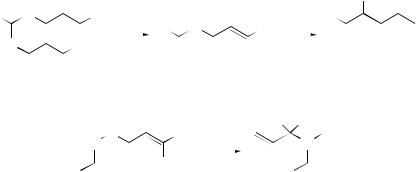
526 |
Organic Reaction Mechanisms 1998 |
complexes has been reported to proceed with remarkably high enantioselectivity.183 The N,N-diethylcarbamoyl group has been shown to act as an efficient director in the (−)-sparteine-mediated enantioselective [2,3]-Wittig rearrangement of o-substituted benzyl allyl ethers,184 and the [2,3]-sigmatropic rearrangement of α-propargyloxyacetic acids has been achieved185 by the use of a BuLi–(−)-sparteine complex. Tomooka et al.186 have demonstrated that a chiral bis(oxazoline) system is effective as an external ligand for the enantioselective [2,3]-Wittig rearrangement of (E)-crotyl propargylic ethers. An asymmetric synthesis of the chiral β-lactone precursor of the HMG–CoA synthase inhibitor L-659,699 has been described.187 It involves, as the key step, an asymmetric [2,3]-Wittig rearrangement to control the stereogenic centres at the ring carbons. It has been reported188 that diallyl acetals (106) undergo reductive cleavage of an allyloxy group by SmI2 to generate α-allyloxy carbanions (107), which can be transformed by a [2,3]-Wittig rearrangement into homoallylic alcohols (108). A novel [2,3]-sigmatropic rearrangement whereby N -benzyl-O-allylhydroxylamines (109) are transformed into the corresponding N -allylhydroxylamines (110) has been described, and evidence for the intramolecular nature of the process has been presented.189 The diastereoselective formation of a 2,8-dioxabicyclo[3.2.1]octane skeleton has been accomplished190 from methyl acetoacetate through the generation and [2,3]- rearrangement of a bicyclic oxonium ylide (see Scheme 45). Apparently, this is the first example of an exocyclic [2,3]-shift from an acetal-derived oxonium ylide.
A study of the mechanism of the rearrangement of a tertiary amine oxide to the O-substituted hydroxylamine has been carried out by the semiempirical AM1 method.191 The use of prolinol as a chiral auxiliary has allowed the formation of single diastereomeric amine N -oxides from N -allyl prolinol derivatives. However, on warming, these amine oxides were found to undergo the [2,3]-Meisenheimer rearrangement with only low stereoselectivity.192 The Meisenheimer rearrangement of allyl N -oxides has been used193 as a route to initiators for nitroxide-mediated freeradical polymerizations. A detailed study of the [2,3]-Meisenheimer rearrangement of 2-vinylazetidine N -oxides has been undertaken.194 A competitive study of the Meisenheimer rearrangement in a substrate tertiary amine with allylic and propargylic
|
|
|
|
|
|
|
|
|
|
R |
R |
O |
R |
|
|
|
|
|
|
R |
|
|
|
|
SmI2 |
R |
|
O |
R |
|
|
|
|
O |
R |
|
− |
|
|
|
|
OH |
|
|
|
(106) |
|
|
|
(107) |
(108) |
|||
|
|
|
|
|
|
|
|
R1 R2 |
||
|
|
O |
|
R |
1 |
|
|
|
OH |
|
|
|
HN |
|
|
|
|
|
N |
||
|
|
Ph |
R2 |
|
|
|
|
Ph |
||
|
|
|
|
|
|
|
||||
|
|
(109) |
|
|
|
|
(110) |
|
||
